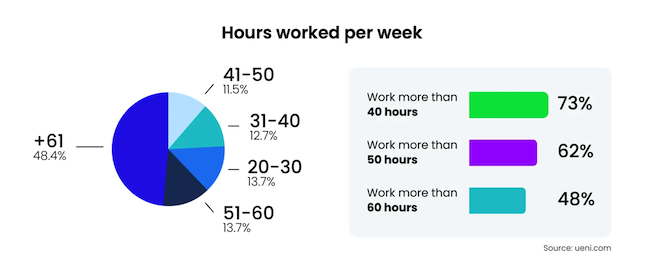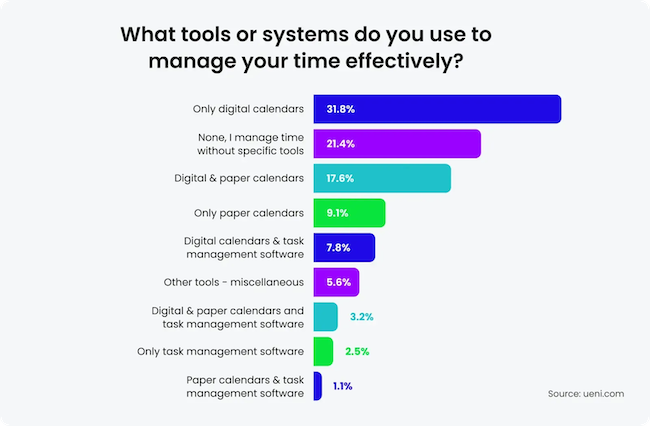How are small firms adapting to drastic changes?
Editor’s note: This is an edited version of an article that originally appeared under the title “Does ‘AI’ Mean ‘Absolute Inequality’ in American Business?”
Tech tools and AI do much of the heavy lifting for time-consuming tasks like bookkeeping, scheduling and even writing content. But as big businesses reap the rewards, are America's smallest firms struggling to adapt?
According to a recent survey, the answer is yes. Between May 6-13, 2024, UENI surveyed 837 U.S. businesses with five or fewer employees to explore how much time micro business owners dedicate to their business, where they spend their time, the nature of their struggles with time management and the tools they use to cope with it. Here are some insights on micro business time management and suggested areas for further research.
Key insight: The hours micro business owners work per week
UENI found that 62% of business owners worked more than 50 hours per week; this is precisely the figure reported in a 2005 Wells Fargo/Gallup poll. The consistency in this data over time dramatically illustrates how many things have remained the same for small business owners despite tremendous progress in all areas of business and technology over the last 20 years.

Key insight: Where do micro business owners spend their time?
Only 33% of business owners’ time is spent directly performing the service or making the product the business sells. The breakdown of time spent across activities points to the diverse activities that compete for the business owner’s attention. Concerningly, administrative tasks combined with legal and compliance consumed, on average, 22% of business owner time, which is 79% more than the amount of time spent on marketing and sales, which are crucial for business growth. Administrative tasks include managing staff, finances, scheduling appointments and inventory.
Eighty-eight percent of business owners allocate time to professional development as an investment in their future success. On average, business owners dedicate 11% of their work time to learning new things. Further investigation is warranted into the nature of the professional development work: Does this learning meaningfully impact their business or would the business owner be better served by delegating or outsourcing the activity they are attempting to learn by themselves?

Key insight: Which tools help micro business owners manage their time?
Seventy-nine percent of micro business owners use tools to manage their time. Of those using tools, only 9% report using exclusively a paper calendar to manage their time, showing the dominance of digital tools, particularly digital calendars like Google Calendar and Outlook. Twenty-one percent of micro business owners do not use any tools to manage their time.
Of the business owners surveyed, 60% reported using a digital calendar, 31% said they used a paper calendar and 15% reported using task management software like Monday.com or Trello. Notably, paper calendars are more than twice as prevalent as task management software overall.
The kinds of time management tools
Forty-five percent of respondents said that they used a single kind of tool, while 34% used more than one kind of tool and 21% used no tools at all. The most prevalent pairing of tools were digital and paper calendars (18%).

The data shows that while digital tools have been extensively adopted by even the smallest businesses, there is still heavy dependence on paper and limited movement into more elaborate and usually paid-for task management tools. Nevertheless, digital calendars’ popularity shows that such businesses can benefit from tech tools that present an easy-to-use interface like Google Calendar, Calendly and UENI.
Key insight: The use of AI in micro businesses
Twenty-five percent of micro business owners use AI to save time in their business. This statistic is consistent with GoDaddy’s February 2024 survey of 3,500 businesses with 10 or fewer employees. This adoption rate among micro businesses contrasts with 65% of enterprises that are already using AI tools internally and 74% that are testing these tools (Deloitte, December 2023). Notably, micro business adoption contrasts even with the behavior of larger small businesses. The SBE Council's October 2023 survey of U.S. small businesses, defined as businesses with fewer than 100 employees, indicated that "75% of small businesses are utilizing AI tools for an expansive range of business functions”.

Micro businesses using AI in their business save five hours per week. This is material, representing 8% of a median 60-hour work week, but there is substantial room for even greater time savings, particularly in managing administrative tasks.
Most experts agree that we are in the very early innings of AI development and the usability of this technology will improve dramatically to increase adoption among solo entrepreneurs and small teams. Productivity gains are likely to come in different areas based on the business in question, but for micro businesses, the largest gains are likely to come from:
- Operational automation to reduce repetitive administrative tasks and assist with things like bookkeeping, scheduling, and inventory management.
- Customer service to interface more ably with customers for an ever-increasing number of questions.
- Marketing automation to write and personalize e-mails and communications as well as digital or offline content that previously took many hours to compose.
- Analytics to review internal data and provide insight that facilitates decision making.
Where will AI save time for micro businesses?
- Bookkeeping.
- Analytics.
- Writing e-mails.
- Scheduling
- Inventory.
- Content creation.
Key insight: Challenges with time management
Eighty-five percent of respondents face challenges managing their time but only 29% of them had strategies to mitigate them.
Why micro business owners struggle to manage their time
- Time constraints (26%): Business owners simply feel like they don’t have enough hours in the day for all the things they need to do. Another 7% explicitly say they need an extra pair of hands to get the work done.
- Focus and distractions (14%): Small business owners struggle to stay on task, with competing priorities, unexpected interruptions, and additional issues impinging on their time, namely personal issues (12%) and an inability to properly prioritize their work (5%).
- Organization and tracking (12%): Poor organization and forgetting things also gets in the way of efficiency. Another 9% lose time because of scheduling issues.
- Personal issues (12%): Children and their own health are the primary personal issues cited by small business owners when describing what has made it hard for them to control their time.
Why do micro businesses struggle with time management?
- Time constraints.
- Focus and distractions.
- Personal issues.
- Organization/Tracking.
- Scheduling.
- Not having enough help.
- Marketing and sales.
- Task prioritization.
- Customer management.
- Specific tasks take up time.
- Difficulty with employees.
Among the 29% of respondents who have a strategy to mitigate time management challenges, most address them with scheduling and planning, tools and technology and self-discipline and focus. These are all logical strategies but are often elusive to a micro business owner who feels overwhelmed with responsibilities.
The pervasiveness of time management problems suggests that micro business owners need more help prioritizing their work and better leveraging themselves. Small business-friendly tools and AI interfaces that make their adoption as easy as using a smartphone are sure to help small business owners cope and possibly achieve more in less time.
Micro business owners are dedicated, but overworked
Micro business owners continue to work overtime, which shows the huge effort involved in running a business and the need to find new sources of efficiency. The median number of hours worked is 50% more than the standard work week.
These business owners are pulled in many directions, often allocating attention to administrative tasks instead of more value-added activities like service and product delivery, marketing and sales. The potential benefits of AI adoption are substantial, but today only a minority are yielding productivity gains. Most micro businesses struggle with time management and require guidance on where to focus their time and how to best leverage technology.
